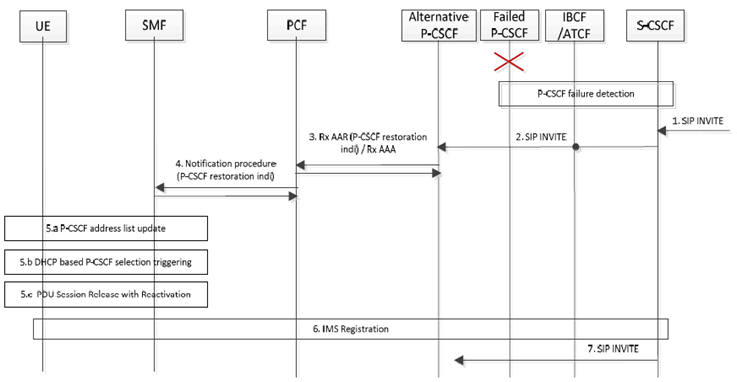Content for TS 23.380 Word version: 18.1.0
5.8.5 PCF Based P-CSCF Restoration
5.8.5.1 Introduction
5.8.5.2 Trigger P-CSCF Restoration Procedure via PCF
5.9 P-CSCF Restoration in EPC with 5GC interworking
5.10 P-CSCF Restoration in EPC for untrusted WLAN when N10 is used instead of S6b
5.8.5 PCF Based P-CSCF Restoration p. 51
5.8.5.1 Introduction p. 51
The PCF based P-CSCF restoration is an optional mechanism.
This mechanism is executed when a terminating request does not proceed due to a P-CSCF failure, as long as there are no other registration flows for this terminating UE using an available P-CSCF.
When P-CSCF failure is detected, the S-CSCF sends a P-CSCF restoration indication through an alternative P-CSCF and the PCF thus initiates IMS PDU session update procedure, so as to trigger the UE re-selects P-CSCF and registers again to IMS.
5.8.5.2 Trigger P-CSCF Restoration Procedure via PCF p. 51
The following Figure 5.8.5.2-1 illustrates the details of PCF based P-CSCF restoration procedure in 5G network.

The P-CSCF failure is detected by S-CSCF or IBCF/ATCF, as specified in clause 5.5.
Step 1.
The S-CSCF receives a terminating INVITE message.
Step 2.
As the failure of the previous P-CSCF is detected, the S-CSCF forwards the Terminating INVITE message to an alternative P-CSCF, as specified in clause 5.5. The S-CSCF may include the address of the failed P-CSCF, if available. The alternative P-CSCF is chosen by local configuration.
Step 3.
The alternative P-CSCF shall send an Rx AAR message or shall invoke the Npcf_PolicyAuthorization_Create service operation with the P-CSCF restoration indication to the associated PCF. The associated PCF is chosen as specified in TS 23.503. The alternative P-CSCF includes, if received, the address of the failed P-CSCF in the request. The PCF shall send an Rx AAA or shall respond the Npcf_PolicyAuthorization_Create request to the P-CSCF.
Step 4.
The PCF sends P-CSCF restoration indication to the SMF serving IMS PDU session, as specified in clause 4.2.3 of TS 29.512; the PCF may include, optionally, the address of the failed P-CSCF.
Step 5.a.
If the requirements listed at clause 5.8.2.2 are fulfilled, the SMF initiates the P-CSCF address list update procedure to trigger the P-CSCF reselection by the UE as specified in clause 5.8.2.2; if the SMF received the address of the failed P-CSCF in the notification from PCF, it may take it into account to build the list of available P-CSCFs that should be sent to the UE.
Step 5.b.
If the requirements listed at clause 5.8.2.3 are fulfilled, the SMF initiates the DHCP based P-CSCF selection triggering procedure to trigger the P-CSCF reselection by the UE as specified in clause 5.8.2.3.
Step 5.c.
Otherwise the SMF initiates the PDU Session Release with Reactivation procedure to the UE, to trigger the UE re-establish IMS PDUS session, as specified in clause 5.8.2.4.
Step 6.
Subsequent to step 8, the UE performs an initial IMS registration towards the new P-CSCF, as specified in clause 5.8.2.
Step 7.
The S-CSCF sends the suspended terminating SIP message to a newly selected P-CSCF after the successful SIP registration for the UE.
5.9 P-CSCF Restoration in EPC with 5GC interworking |R15| p. 52
If IMS service is required in EPC with 5GC interworking as specified in TS 23.501, HSS+UDM and PGW-C+SMF are involved in the P-CSCF procedures.
After mobility from 5GC to EPC happens for a UE as specified in TS 23.502, the MME via S6a (or AAA for WLAN via SWx) registers itself to HSS+UDM and PGW-C+SMF registered itself via N10 in the HSS+UDM when the UE was in 5GC. In this case, when P-CSCF restoration indication is received from S-CSCF, the HSS+UDM shall, either:
- send a P-CSCF restoration indication to the MME serving the UE as specified in clause 5.4 "HSS-based P-CSCF restoration for 3GPP access", or to the AAA for WLAN as specified in clause 5.6.2 "Basic mechanism for the HSS-based solution", or
- send a P-CSCF restoration indication via N10 interface to the PGW-C+SMF serving IMS PDN connection as described in clause 5.8.4.2 step 6, and the PGW-C+SMF thus initiates IMS PDN connection update procedure in EPC or the IMS PDN connection deactivation with reactivation required, to trigger the UE re-selects P-CSCF and registers again to IMS as described in clause 5.4.3.2 from step 8 to 10, in clause 5.6.2.2 from step 8 to 10, or in clause 5.6.5.2 step 8 to 11.
5.10 P-CSCF Restoration in EPC for untrusted WLAN when N10 is used instead of S6b |R16| p. 53
If the IMS service is required to be served by untrusted WLAN where N10 is used instead of S6b interface as specified in TS 23.502, the AAA registers itself in HSS+UDM via SWx interface, and PGW-C+SMF registers itself in HSS+UDM via N10.
When P-CSCF restoration indication is received, the HSS+UDM shall send a P-CSCF restoration indication via N10 interface to the PGW-C+SMF serving the IMS PDN connection as described in clause 5.9 to continue with the P-CSCF restoration.